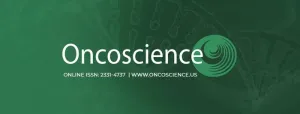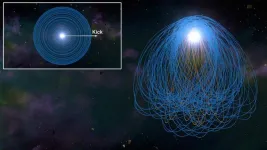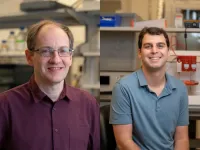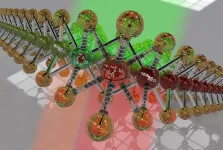(Press-News.org) Acute myeloid leukemia (AML) is a type of blood cancer that forms in the soft marrow of the bones, typically attacking cells that would otherwise form the key component of the body’s immunodefense system, white blood cells.
In a new study published in Blood Advances, researchers from the UChicago Pritzker School of Molecular Engineering’s Hubbell Lab created with a novel approach to develop in-situ cancer vaccines that could increase the effectiveness of immunotherapies in AML and other blood cancers.
“We are trying to come up with cancer vaccine approaches that could be more easily scaled and applied, in other words, one type of vaccine that works with a number of cancers,” said Prof. Jeffrey Hubbell, the Eugene Bell Professor in Tissue Engineering at PME.
Powerful protection against pathogen attacks
Vaccination is a well-known method to prevent diseases caused by a variety of pathogens like bacteria and viruses. It works by exposing a small part of the pathogen — usually a protein – to the immune system so that immune cells are primed to fight off incoming pathogens.
Our immune system not only safeguards us from pathogen attacks but also protects against any abnormal changes happening within the body. For example, immune cells can identify abnormal mutated proteins or cancer cells and eliminate them from the system. Thus, cancer vaccination has emerged as a powerful tool to harness the immune system to treat cancers.
Some vaccines work by preventing specific cancers from developing, such as the human papilloma virus (HPV) vaccine that protects against a virus that can cause cervical cancer. Other vaccines are therapeutic vaccines, meaning to prime immunity to attack existing cancers. This new research falls into the latter category.
From an immune perspective, cancer can often appear exactly like healthy tissue, so the immune system does not always initiate a response against it unprompted, said Pritzker Molecular Engineering doctoral candidate Anna Slezak, the first author of the paper.
Slezak, who is also a trainee associate member of the University of Chicago Medicine Comprehensive Cancer Center, is trying to identify key differences in cancer cells so those unique attributes can be targeted to drive a specific immunological response against the cancer cells as opposed to healthy tissues.
Immune cell targets, or antigens, are usually the mutated proteins of the cancer cells. For many years, scientists have been sequencing tumor biopsy samples to identify target proteins that can be used to develop vaccines. This knowledge-based approach can be very useful in making personalized vaccines, but it becomes a laborious process.
Exploiting unique features of cancer cells
Recently, Hubbell’s team leveraged a unique feature of cancer cells to develop a generalized cancer vaccine. Tumor cells, unlike healthy cells, have unpaired cysteine molecules on their surfaces as a result of metabolic and enzymatic dysregulation. These unpaired cysteines provide a tumor cell-enriched chemical feature that can be exploited to target their material specifically to the cancer cells.
Attaching an adjuvant, usually a drug or chemical substance, to the material that tags free thiols can enhance the immune response and turn the tumor cell itself into the vaccine, simply by injecting the material into the blood.
“Our material binds specifically to these free thiols and can covalently link our adjuvant to the tumor cell, tumor debris, whatever the thiol is attached to,” Slezak said. This is a way to tag cancer cells or debris of dying cancer cells in the circulating blood for immune recognition and trigger immunity to their mutated proteins.
The construct also contains mannose, a type of sugar group, and a Toll-like receptor-7 (TLR-7) agonist. The mannose groups help traffic the debris to antigen-presenting cells (APCs) residing in the liver and spleen, and TLR-7 is required for immune system activation. Once APCs engulf the construct, it triggers TLR-7-mediated immune response against the debris or cancer cells.
Chemotherapy enhances the cancer vaccine effects
To generate a more effective response, the researchers combined vaccine delivery with cytarabine treatment, a chemotherapy commonly administered in AML patients.
“Combination therapies are hard to develop, but they tend to be more effective than monotherapies,” Hubbell said.
In this study, the combination treatment with low-dose cytarabine significantly increased the survival rate after intravenous administration of the vaccine. As this vaccine approach does not target any specific cancer protein, the study authors said it may have applicability in other hematological malignancies.
“People have tried this concept before with using antibodies to target the tumor cell rather than the polymer, like an antibody-drug conjugate or an antibody-adjuvant conjugate,” Hubbell said. “But here we are coming up with an approach that does not require a targeting antibody. That's a big advantage over what's been tried before in this tumor cell-targeted adjuvant concept.”
Future work of the Hubbell lab will focus on the chemistry of novel vaccines, particularly asking questions about what kind of an immune adjuvant or other molecules can be attached to the material that tags cancer cells to yield exciting outcomes in cancer treatments. The rearchers note that there is much more preclinical work that is necessary before the approach would be ready for clinical testing.
Citation: “Cysteine-binding adjuvant enhances survival and promotes immune function in a murine model of acute myeloid leukemia,” Slezak et al, Blood Advances, April 9, 2024. DOI: 10.1182/bloodadvances.2023012529
Funding: Chicago Immunoengineering Innovation Center of the University of Chicago, National Institutes of Health (CA253248)
END
One vaccine, many cancers
A new approach for developing cancer vaccines could make immunotherapies more effective in acute myeloid leukemia
2024-05-03
ELSE PRESS RELEASES FROM THIS DATE:
nTIDE April 2024 Jobs Report: Post-pandemic gains seen in employment for people with disabilities appear to continue
2024-05-03
East Hanover, NJ – May 3, 2024 – Following a two-month decline, the employment of individuals with disabilities returns to near historic highs reported by nTIDE in late 2023, reaffirming the significance of those prior highs. That’s according to today’s National Trends in Disability Employment – semi-monthly update (nTIDE), issued by Kessler Foundation and the University of New Hampshire’s Institute on Disability (UNH-IOD).
Month-to-Month nTIDE Numbers (comparing March 2024 to April 2024)
“Following two months of decline, individuals with disabilities are now edging back towards their near ...
Exploring oncogenic driver molecular alterations in Hispanic/Latin American cancer patients
2024-05-03
“[...] this editorial underscores the complex molecular diagnosis landscape of cancer in the [Latin American] population.”
BUFFALO, NY- May 3, 2024 – A new editorial paper was published in Oncoscience (Volume 11) on April 22, 2024, entitled, “Exploring oncogenic driver molecular alterations in Hispanic/Latin American cancer patients: A call for enhanced molecular understanding.”
In this new editorial, researcher Rafael Parra-Medina from Fundación Universitaria de Ciencias de la Salud and Instituto Nacional de Cancerología begins by discussing Latin America’s (LA) population — a heterogeneous mix ...
Hungry, hungry white dwarfs: solving the puzzle of stellar metal pollution
2024-05-03
Dead stars known as white dwarfs, have a mass like the Sun while being similar in size to Earth. They are common in our galaxy, as 97% of stars are white dwarfs. As stars reach the end of their lives, their cores collapse into the dense ball of a white dwarf, making our galaxy seem like an ethereal graveyard.
Despite their prevalence, the chemical makeup of these stellar remnants has been a conundrum for astronomers for years. The presence of heavy metal elements—like silicon, magnesium, and calcium—on the surface of many of these compact objects is a perplexing ...
New study reveals how teens thrive online: factors that shape digital success revealed
2024-05-03
A new study co-authored by Sophie Janicke-Bowles, associate professor in Chapman University’s School of Communication, sheds light on the role that new and traditional media play in promoting and affecting character development, emotions, prosocial behavior and well-being (aka happiness) in youth.
Her research and teaching focus on positive psychology, media and new communication technologies, and media and spirituality. The study, published April 13 in Society for Research in Child Development (SRCD), investigates how adolescents perceive ...
U of T researchers discover compounds produced by gut bacteria that can treat inflammation
2024-05-03
Researchers at the University of Toronto have found naturally occurring compounds in the gut that can be harnessed to reduce inflammation and other symptoms of digestive issues. This can be achieved by binding the compounds to an important, but poorly understood, nuclear receptor.
The gut microbiome hosts bacteria that produce compounds as by-products of feeding on our digestive remnants. The compounds can bind to nuclear receptors, which help transcribe DNA to produce proteins and non-coding RNA segments.
By identifying ...
Aligned peptide ‘noodles’ could enable lab-grown biological tissues
2024-05-03
HOUSTON – (May 3, 2024) – A team of chemists and bioengineers at Rice University and the University of Houston have achieved a significant milestone in their work to create a biomaterial that can be used to grow biological tissues outside the human body. The development of a novel fabrication process to create aligned nanofiber hydrogels could offer new possibilities for tissue regeneration after injury and provide a way to test therapeutic drug candidates without the use of animals.
The research team, led by Jeffrey Hartgerink, professor of chemistry and bioengineering, has developed peptide-based hydrogels that mimic the aligned structure of muscle and ...
Law fails victims of financial abuse from their partner, research warns
2024-05-03
Victims of financial abuse from their partner in England and Wales are being failed by an “inadequate” legal response, new research warns.
Coerced debt causes considerable harm. People often live with the effects of being forced to give money or take out loans or credit cards long after the abusive relationship has ended.
Using the law to tackle it is more complex than other forms of abuse because to be free of the harmful effects of the abuse people’s contractual liability for the debt may need to be set aside. The law often favours lenders, who have little obligation to ensure that transactions are free from coercion.
New research recommends ...
Mental health first-aid training may enhance mental health support in prison settings
2024-05-03
According to Rutgers Health researchers, training correctional officers in Mental Health First Aid (MHFA) for adults, a 7.5-hour national education program from the National Council of Mental Wellbeing, may help provide them with the necessary skills to effectively identify signs and symptoms of mental distress and advocate for incarcerated individuals facing mental health crises.
Led by Pamela Valera, an assistant professor in the Department of Urban-Global Public Health at Rutgers School of Public Health, ...
Tweaking isotopes sheds light on promising approach to engineer semiconductors
2024-05-03
Research led by scientists at the Department of Energy’s Oak Ridge National Laboratory has demonstrated that small changes in the isotopic content of thin semiconductor materials can influence their optical and electronic properties, possibly opening the way to new and advanced designs with the semiconductors.
Partly because of semiconductors, electronic devices and systems become more advanced and sophisticated every day. That’s why for decades researchers have studied ways to improve semiconductor compounds to influence how they carry electrical current. One approach is to use isotopes to ...
How E. coli get the power to cause urinary tract infections
2024-05-03
Through a quirk of anatomy, women are especially prone to urinary tract infections, with almost half dealing with one at some point in their lives.
Scientists have been trying to figure out for decades how bacteria gain a foothold in otherwise healthy people, examining everything from how the microbes move inside and stick to the inside of the bladder to how they deploy their toxins to produce uncomfortable and often painful symptoms.
Research published in PNAS examines how the bacteria Escherichia coli, or E. coli—responsible for most UTIs—is able to use host nutrients to reproduce at an extraordinarily rapid pace during ...
LAST 30 PRESS RELEASES:
Making lighter work of calculating fluid and heat flow
Normalizing blood sugar can halve heart attack risk
Lowering blood sugar cuts heart attack risk in people with prediabetes
Study links genetic variants to risk of blinding eye disease in premature infants
Non-opioid ‘pain sponge’ therapy halts cartilage degeneration and relieves chronic pain
AI can pick up cultural values by mimicking how kids learn
China’s ecological redlines offer fast track to 30 x 30 global conservation goal
Invisible indoor threats: emerging household contaminants and their growing risks to human health
Adding antibody treatment to chemo boosts outcomes for children with rare cancer
Germline pathogenic variants among women without a history of breast cancer
Tanning beds triple melanoma risk, potentially causing broad DNA damage
Unique bond identified as key to viral infection speed
Indoor tanning makes youthful skin much older on a genetic level
Mouse model sheds new light on the causes and potential solutions to human GI problems linked to muscular dystrophy
The Journal of Nuclear Medicine ahead-of-print tip sheet: December 12, 2025
Smarter tools for peering into the microscopic world
Applications open for funding to conduct research in the Kinsey Institute archives
Global measure underestimates the severity of food insecurity
Child survivors of critical illness are missing out on timely follow up care
Risk-based vs annual breast cancer screening / the WISDOM randomized clinical trial
University of Toronto launches Electric Vehicle Innovation Ontario to accelerate advanced EV technologies and build Canada’s innovation advantage
Early relapse predicts poor outcomes in aggressive blood cancer
American College of Lifestyle Medicine applauds two CMS models aligned with lifestyle medicine practice and reimbursement
Clinical trial finds cannabis use not a barrier to quitting nicotine vaping
Supplemental nutrition assistance program policies and food insecurity
Switching immune cells to “night mode” could limit damage after a heart attack, study suggests
URI-based Global RIghts Project report spotlights continued troubling trends in worldwide inhumane treatment
Neutrophils are less aggressive at night, explaining why nighttime heart attacks cause less damage than daytime events
Menopausal hormone therapy may not pose breast cancer risk for women with BRCA mutations
Mobile health tool may improve quality of life for adolescent and young adult breast cancer survivors
[Press-News.org] One vaccine, many cancersA new approach for developing cancer vaccines could make immunotherapies more effective in acute myeloid leukemia





